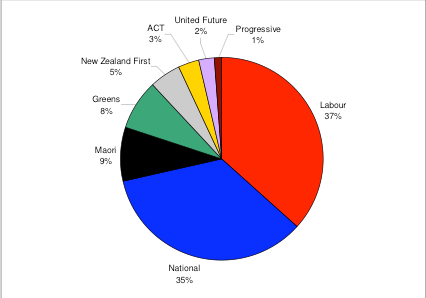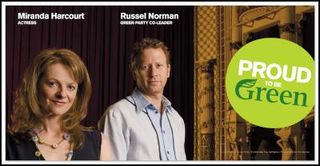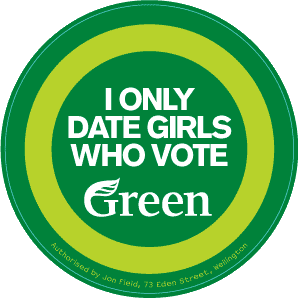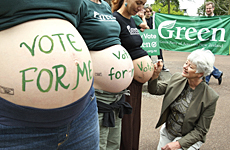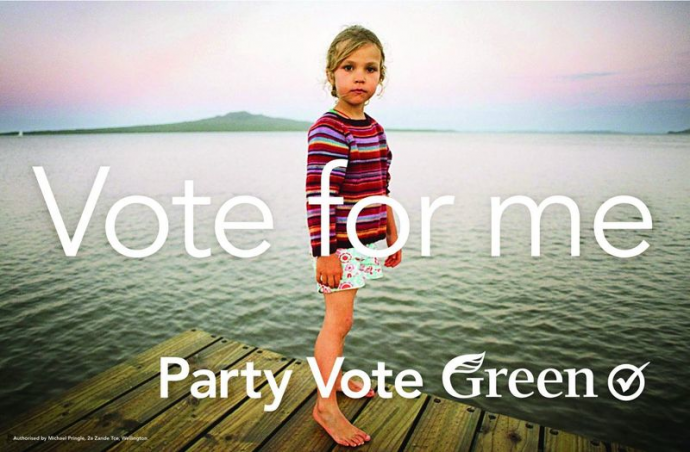AWA: Academic Writing at Auckland
Title: Analysis of the Green Party's political advertising campaign for the 2008 New Zealand General Election
|
Copyright: Victoria Gibson
|
Description: The Green Party's political advertising in the 2008 election. This advertising won an international award. To what extent was it effective in achieving the party goals and gaining public support?
Warning: This paper cannot be copied and used in your own assignment; this is plagiarism. Copied sections will be identified by Turnitin and penalties will apply. Please refer to the University's Academic Integrity resource and policies on Academic Integrity and Copyright.
|
Writing features
|
Analysis of the Green Party's political advertising campaign for the 2008 New Zealand General Election
|
Introduction The Green Party of Aotearoa spent NZ$1.75m on its award winning, professionally crafted, 2008 election advertising campaign.[1] This report analyses content from newspapers, websites, case studies, and articles, and applies it to academic models and theories researched from academic books, journals and theses. The report aims to analyse and assess the Greens’ campaign effectiveness in terms of the additional public support the Greens gained, and the degree to which the Party’s goals were achieved. It concludes that the communication strategy was successful in partially achieving the Green Party’s goals and recommends that they continue with this marketing approach for the 2011 election, whilst removing some identified barriers to further success. 1. Context for the Green Party’s 2008 New Zealand General Election Campaign Karen Sanders identifies that political campaigns are affected by three changeable conditions:
1.1 The factors affecting the Greens in 2008 Environmental factors:
Structural factors:
Resource variables:
2. The goals of the Green Party’s campaign Special Group condensed the Greens’ objectives in their case study notes: ‘to maximize the number of people who voted for the Green Party and thereby insure its position in Parliament… [to] grow its vote from 2005’s 5.3%... and increase its representation from just six MP’s.’[17] However, this can be expanded to:
3. The Campaign The award winning ‘Vote for Me’ campaign was launched on the 5th September, and marked the final stage in the Greens’ 2008 marketing campaign. The campaign featured billboards and short TVC’s with simple imagery, such as a child against a backdrop of Rangitoto and Auckland Harbour, or an image of the Earth. This imagery was supported by minimal wording - ‘Vote for Me’, and an instruction to ‘Party Vote Green’. The Green Party logo was prominent.[24] The campaign built upon a strategic pre-election campaign that began early in 2008 with the celebrity endorsed, ‘Proud to be Green’ billboards (appendix 1.a). Additionally, a viral YouTube video campaign, ‘some things are above politics’, was released throughout the year. Targeting the youth vote, this contained a mixture of positive and negative elements, such as the irreverently negative, boxing caricature video of Trevor Mallard. Additionally, a strong website, facebook and twitter presence enhanced this viral sector of their marketing. The Green’s campaign was assessed as the most positively toned campaign of the 2008 election.[25] 3.1 Campaign Strategy This campaign fullfilled two out of three of Hayward and Rudd’s model of modern political campaign principles.[26] The Greens:
However, the third factor in Hayward and Rudd’s model, that it be driven by leadership and personality, was ignored by the Green Party.[29] The Greens campaign also showed elements of Diamond and Bates’ model for a successful campaign.
3.2 Communication Media used The campaign was communicated both through traditional media:
And, viral internet-based media:
3.3 The Greens media strategy They strategically:
The campaign strategy could also be said to utilize the hypodermic needle theory, as the same message was repeated constantly and consistently.[38]
3.4 The Greens creative strategy The strategy was to:
4. The application of commercial marketing techniques The Greens campaign strategy applied brand marketing theory in an attempt to build voter loyalty and gain a competitive advantage through strong brand awareness and association.[45] The image-based ads, with the Green Party logo a prominent feature, were designed for brand recognition with voters (appendix 1.d).[46] The Greens’ TVC’s were designed to elicit an emotional response from the viewer and influence political participation by voting Green.[47] Brader’s research confirms that emotion-targeting ads can influence viewer behaviour.[48] The Greens’ campaign used devices such as:
These elements were designed, according to Russel Norman, to create an ‘… emotional, heartfelt connection with voters….’[50] 4.1 The ad campaign compared against the Lees-Marshment Model of Political Marketing The campaign strategy showed strong elements of political marketing theory,[51] and appears to contain a mixture of market-orientated and sales-orientated elements. When compared against the Lees-Marshment model the following advertising aspects can be classified according to their marketing orientation:[52] 4.1.2 Market-orientated elements
4.1.3 Sales-orientated elements
4.2 The Greens campaign in relation to Claire Robinson’s Market-Orientated Advertising Criteria Model When compared against Robinson’s model,[66] The Greens’ campaign can be seen to adhere in some respects to all of the five principles: target audience identification, response to voter need, voter relations management, offered in exchange, and competitor orientation. 4.2.1 The ‘Vote for Me’ TVC’s and billboards analysis against Robinson’s model Target audience identification:
Responded to voter need:
However, target market and candidate interactive imagery was absent.[73] Voter relations:
Head of M&C Saatchi, Nick Baylis, said the ads: ‘… clearly and refreshingly communicate the core philosophy of the party and more importantly, promise me a benefit in return for my vote.’[75] Offered in exchange: The benefit communicated was the distinct alternative the Green Party ‘offered in exchange’. This was evidenced by:
Competitor orientation:
5. The Viral Campaign E-marketing, using facebook, YouTube, twitter and websites, was utilized effectively during the Greens’ campaign as a whole.[80] This was in harmony with their young ‘internet-savvy’ core-voters.[81] The Greens identified that this market segment would be receptive to short, humorous, negatively-toned or irreverent clips, such as their ‘bloopers’ video.[82] The YouTube campaign’s engagement effectiveness can be illustrated by the 30,000 views gained during the whole campaign.[83]
Seeking to ‘refresh’ the campaign in the final two weeks before the election, the Greens set up a mini-interactive-website.[84] This invited the public to create a personal ‘Vote for Me’ billboard and upload it onto the site. The benefits of this were:
6. Effectiveness of the campaign Opinion regarding the effectiveness of this campaign has been mixed. Sunday Times reporter, Esther Harward, called it ‘brilliant’ delivering the Greens a ‘powerful performance’ at the election.[90] However, some think that the campaign was not as effective as it could have been. Bryce Edwards recognized that the Greens, regardless of their campaign budget, seem unable to rise above 7% of the vote and that the campaign, ‘actually didn’t do the party much good.’[91] Jack Vowles agrees, stating that: ‘… although it increased [Greens’] vote and seats, this advance was marginal.’[92]
6.1 Effectiveness in gaining voter support This may in part be assessed by increasing Green Party popularity showing in polling results throughout 2008:
The table below [Table 1] shows that, of their public support goals, the Greens increased their:
However, the table also highlights that they have not significantly increased their percentage of the vote at any time, and their performance in the 2008 election actually delivered them less party votes than their first election in 1990. The Greens had expected to receive a greater share of the party vote, but they failed to reach their target of 10%.[96] However, their vote increase was the greatest it had ever been, and their polling results showed their popularity had doubled from what it had been in January.[97] Table 1: Comparing historical election data for the Green Party at New Zealand General Elections.
Information source: New Zealand Parliament Documents and New Zealand Election Results.[98] 6.2 Effectiveness of the campaign generally Catherine Delahunty stated that it was, ‘…[a] very successful campaign to increase our vote … our caucus is now the strongest it has ever been.’[99] The Greens’ campaign demonstrated this effectiveness:
7. Elements that may have adversely affected the campaign The Green Party campaigned on three post-materialist issues:
The saliency of these platforms to voters was undermined by the GFC, as polling revealed that only 1.4% of voters identified the environment as the most important issue, and less than 1% were concerned with energy and transport.[109] Compare that with a 50% voter focus on the economy as the most important issue.[110] There were also a number of hypocrisies evident in their campaign, which may have undermined their credibility:
7.1 Media Coverage The impact of the GFC resulted in media coverage allocation of only 4% for environmental issues, compared with 40% for tax and the economy.[118] Herman and Chomsky’s ‘media filter’ may also be responsible for this lack of coverage. Advertisers may find the Greens’ policies incompatible with their commercial enterprises, which may negatively effect the media’s inclination to give them space.[119] Additionally, minor party leaders were excluded from publicly broadcasted debates, with the media focusing on a ‘two-horse race’ between Clark and Key.[120] The Greens’ leaders received only 2% of total Party leader coverage.[121] The following table [Table 2] highlights some inequalities in press coverage during the 2008 election campaign.
Table 2: Table comparing the press coverage of the three most successful Parliamentary Parties and their leaders.
Source: Bryce Edwards. "Newspaper Coverage of the 2008 NZ Election."[122] And, Dr Babak Bahador. "New Zealand Media Coverage of the 2008 Election Study: Preliminary Results."[123]
Figure 1. Volume of media coverage of New Zealand Parties
Source: Dr Babak Bahador. "New Zealand Media Coverage of the 2008 Election Study.[1] The Greens’ media coverage was the most positive of all the parties (appendix 2.a).[2] However, compared with the two major parties the Green Party received marginal media coverage (Fig. 1).[3] As research shows public opinion may be influenced by frequent media coverage and debate,[4] this marginalisation of the Greens may help explain their inability to rise above the 7% party vote mark. 8. Recommendations for the Green’s 2011 strategy When considering the elements of their campaign success and the factors that may have impeded the Green’s election success, the following recommendations can be postulated:
9. The democratic implications of the Greens’ market and sales-orientated campaign The Greens, although taking a more market-orientated approach in their ideological, centre-left move and their brand-based campaigning, are mainly consistent in their policy focus and development. They did not seem responsive to polling results by adapting their policies, and so therefore the democratic will of the people was expressed by their votes, rather than in policy change.[8] It may be opined, in light of Brader’s research into the ‘connections between campaign communication, emotional responses, and attitude change’[9] that the Greens manipulated such a response by their campaign, and therefore captured an increased market. However, this may alternatively be explained by Labour deserters, choosing them as a default vote. The media, in their marginalization of the minor parties, has a part to play in the democratic process. The freedom of the press is a ‘crucial feature of a democratic system.’[10] However, research showing that media focus influences voters, means that their bias towards the two major parties does not provide the voter with a balanced information foundation upon which to base their voting behaviour. 10. Summary The Greens’ 2008 advertising campaign had moved towards a market-orientated approach, whilst retaining many features of a sales-orientated campaign. This worked well for the Greens’ as they increased their broad support and consequently their Party caucus. However, they failed to achieve their party vote goal of 10%. This may have been due to some inconsistencies with their ‘above politics’ positioning, some undermining hypocrisies, and a relative lack of media attention. It is therefore recommended for New Zealand’s 2011 general election, that the Greens continue with this campaign strategy, eliminating areas of inconsistency, with an aim to leveraging off the strength of their internet mediums, and gaining an increase in mainstream media focus.
Bibliography Bahador, Dr Babak. "New Zealand Media Coverage of the 2008 Election Study: Preliminary Results." Canterbury: University of Canterbury, 2008. Bartle, John, and Dylan Griffiths, eds. Political Communications Transformed: From Morrison to Mandelson. Bassingstoke: Palgrave, 2001. Brader, Ted. "Striking a Responsive Chord: How Political Ads Motivate and Persuade Voters by Appealing to Emotions." American Journal of Political Science 49, no. 2 (2005): 388-405. Craig, Geoffrey, Janine Hayward, and Chris Rudd, eds. Informing Voters?: Politics, Media and the New Zealnd Election 2008. Australia: Pearson Education, 2009. Delahunty, Catherine. "The Greens." In Key to Victory: The New Zealand General Election of 2008, edited by S Levine and N S Roberts, 377. Wellington: Victoria University Press, 2010. Donald, Holly Kate Shirlaw. "Principled Non-Voters and Postmaterialist Theory: An Exploratory Analysis of Young Principled Non-Voters in New Zealand." University of Canterbury, 2010. Edwards, Bryce. "Greens Spent $1.7m in 2008 Election Campaign." Liberation (2009). Edwards, Bryce. "Have the Greens Sold Their Soul?" Liberation (2008). Edwards, Bryce. "Newspaper Coverage of the 2008 Nz Election." Liberation (2008). Edwards, Bryce. "The Greens' 2008 Election Campaign." Liberation (2009). Frog. "Number Crunching." Frogblog (2008). Gillett, Lizzie, and James Shaw. "Kiwi Greens Launch Expat Election Campaign." Scoop Independant News (2008). Gorman, Paul. "Green Leaders." The Press (2008). Government, New Zealand. "Election Advertising Rules - Summary." edited by Elections New Zealand. Wellington. Government, New Zealand. "Party Rules." edited by Elections New Zealand. Wellington. Government, New Zealand. "Returns of Party Donations Exceeding $20,000." edited by Elections New Zealand. Wellington. Government, New Zealand. "Two Ticks? Too Easy! - Mmp Basics." edited by Elections New Zealand. Wellington. Green Party, Aotearoa. "Web Advert." The Green Party of Aotearoa New Zealand. Group, Special. "2009 Eefie Awards Case Study." 2. Auckland: CAANZ - Communication Agencies Association 2009. Group, Special. "Making Ideas Bigger: The Green Party Viral." 17. Auckland, 2008. Group, Special. Vote for Me Tvc. Auckland: The Green Party of Aotearoa, 2008. Harward, Esther. "Clear Winners of Ad Campaign." Sunday Star Times, 9th Nov 2008, 4. Herald, New Zealand. "Greens Emerge as Surprise Poll Package." The New Zealand Herald, 25th October 2008. Herman, Edward Ss., and Noam Chomsky. Manufacturing Consent: The Political Economy of the Mass Media. New York: Pantheon, 2002. Holt, Sue. "Television Coverage of Election Campaigns: Do Broadcasters Have Public Law Obligations?" The New Zealand Postgraduate Law e-Journal, no. 4: 35. Houlahan, Mike. "Election Campaign." The Press (2008). James, Colin. "Marketing Maxim: Keep It Chrystal Clear." New Zealand Herald (2008). Kean, Nicola. "2008: The Campaign in Cyberspace." In Key to Victory: The New Zealand General Election of 2008, edited by S Levine and N S Roberts, 377. Wellington: Victoria university Press, 2010. Lees-Marshment, J, C Rudd, and J Stromback, eds. Global Political Marketing. London: Routledge, 2009. Lees-Marshment, Jennifer. "The Lees-Marshment Model: Debating Voter Input into Political Decision Making." lees-marshment.org. Levine, Stephen, and Nigel S Roberts. "2008: Key to Victory." In Key to Victory: The New Zealand General Election 2008, edited by S Levine and N S Roberts, 377. Wellington: Victoria University Press, 2010. Levine, Stephen, and Nigel S Roberts. "2008: Voting Behaviour and the Keys to Victory." In Key to Victory: The New Zealand General Election of 2008, edited by S Levine and N S Roberts, 377. Welington: Victoria University Press, 2010. Luke, Peter. "Problems for Greens." Sunday Star-Times (2008). Merchandise, Logo. "Brand Marketing Is the Core of Brand Theory and Marketing Theory Combination." News, Scoop Independent. "How the Numbers Add up, for Labour." NZCPR Weekly (2008). Norman, Russel. "The Green Party 2008 Election Campaign Launch." Te Papa, Wellington, 5th September 2008. Paula. "Minor Problem of Getting Case Heard." The Daily Post (2008). Phillips, Hazel. "Ad Land Gives Special and Greens the Thumbs-Up." The National Business Review (2008). Robinson, Claire. "'Vote for Me': Political Advertising." In Informing Voters?: Politics, Media and the New Zealand Election 2008, edited by Geoffrey Craig, Janine Hayward and Chris Rudd, 172. Australia: Pearson Education, 2009. Salmond, Rob. "2008: The Youtube Campaign." In Key to Victory: The New Zealand General Election of 2008, edited by S Levine and N S Roberts, 377. Wellington: Victoria University Press, 2010. Sanders, Karen. Communicating Politics in the Twenty-First Century. Bassinstoke: Palgrave MacMillan, 2009. Simpson, Alan. "Media Polls Ensure No Surprises at Outcome." Waikato Times, 10th November 2008. Sparrow, Nick, and John Turner. "The Permanent Campaign: The Integration of Market Research Techniques in Developing Strategies in a More Uncertain Political Climate." European Journal of Marketing 35, no. 9 (2001): 984-1002. Vowles, Jack. "The 2008 General Election in New Zealand." Exeter: University of Exeter, 2008. Zealand, Green Party of Aotearoa New. 2008 Election Campaign Launch. Te Papa, Wellington: Green Party of Aotearoa New Zealand, 2008.
[1] Bryce Edwards, "Greens Spent $1.7m in 2008 Election Campaign," Liberation (2009). http://liberation.typepad.com/liberation/2009/03/greens-spent-17m-in-2008-election-campaign.html [2] Karen Sanders, Communicating Politics in the Twenty-First Century (Bassinstoke: Palgrave MacMillan, 2009). 166-7. [3] Bryce Edwards, "The Greens' 2008 Election Campaign," Liberation (2009). http://liberation.typepad.com/liberation/2009/09/the-greens-2008-election-campaign.html [4] Stephen Levine and Nigel S Roberts, "2008: Voting Behaviour and the Keys to Victory," in Key to Victory: The New Zealand General Election of 2008, ed. S Levine and N S Roberts (Welington: Victoria University Press, 2010). 237. [5] Ibid. 227. [6] Ibid. 227. [7] New Zealand Government, "Party Rules," ed. Elections New Zealand (Wellington). http://www.elections.org.nz/rules/parties/partysub [8] Edwards, "The Greens' 2008 Election Campaign." [9] Claire Robinson, "'Vote for Me': Political Advertising," in Informing Voters?: Politics, Media and the New Zealand Election 2008, ed. Geoffrey Craig, Janine Hayward, and Chris Rudd (Australia: Pearson Education, 2009). 85. [10] Dr Babak Bahador, "New Zealand Media Coverage of the 2008 Election Study: Preliminary Results," (Canterbury: University of Canterbury, 2008). [11] New Zealand Government, "Election Advertising Rules - Summary," ed. Elections New Zealand (Wellington). http://www.elections.org.nz/rules/parties/partysub/e5-party-advertising-summary.html [12] New Zealand Government, "Two Ticks? Too Easy! - Mmp Basics," ed. Elections New Zealand (Wellington). http://www.elections.org.nz/voting/mmp/two-ticks-too-easy.html [13] Edwards, "The Greens' 2008 Election Campaign." [14] New Zealand Government, "Returns of Party Donations Exceeding $20,000," ed. Elections New Zealand (Wellington). http://www.elections.org.nz/rules/donations/returns-donations-exceeding-20k.html [15] Edwards, "The Greens' 2008 Election Campaign." [16] Robinson, "'Vote for Me': Political Advertising." 85. [17] Special Group, "2009 Eefie Awards Case Study," (Auckland: CAANZ - Communication Agencies Association 2009). [18] Robinson, "'Vote for Me': Political Advertising." 85. [19] Ibid. [20] Group, "2009 Eefie Awards Case Study." [21] Paul Gorman, "Green Leaders," The Press (2008). http://www.knowledge-basket.co.nz.ezproxy.auckland.ac.nz/search/doc_view.php?d149=ffx03/text/2008/10/29/doc00345.html [22] Lizzie Gillett and James Shaw, "Kiwi Greens Launch Expat Election Campaign," Scoop Independant News (2008). [23] Group, "2009 Eefie Awards Case Study." [24] Special Group, Vote for Me Tvc (Auckland: The Green Party of Aotearoa, 2008). [25] Rob Salmond, "2008: The Youtube Campaign," in Key to Victory: The New Zealand General Election of 2008, ed. S Levine and N S Roberts (Wellington: Victoria University Press, 2010). 215. [26] Sanders, Communicating Politics in the Twenty-First Century. [27] Robinson, "'Vote for Me': Political Advertising." 78. [28] Edwards, "The Greens' 2008 Election Campaign." [29] Geoffrey Craig, Janine Hayward, and Chris Rudd, eds., Informing Voters?: Politics, Media and the New Zealnd Election 2008 (Australia: Pearson Education, 2009). 16. [30] Group, "2009 Eefie Awards Case Study." [31] Robinson, "'Vote for Me': Political Advertising." 76. [32] Group, "2009 Eefie Awards Case Study." [33] Ibid. [34] Special Group, "Making Ideas Bigger: The Green Party Viral," (Auckland: 2008). [35] Group, "2009 Eefie Awards Case Study." [36] Paula, "Minor Problem of Getting Case Heard," The Daily Post (2008). http://www.knowledge-basket.co.nz.ezproxy.auckland.ac.nz/search/doc_view.php?d68=nzh02/text/2008/11/02/ROT-01PAULA.html [37] Group, "Making Ideas Bigger: The Green Party Viral." [38] Sanders, Communicating Politics in the Twenty-First Century. 13. [39] Group, "2009 Eefie Awards Case Study." [40] Ibid. [41] Robinson, "'Vote for Me': Political Advertising." 85. [42] Group, "2009 Eefie Awards Case Study." [43] Ibid. [44] Edwards, "The Greens' 2008 Election Campaign." [45] Logo Merchandise, "Brand Marketing Is the Core of Brand Theory and Marketing Theory Combination." http://branded-advertising.blogspot.com/2009/01/brand-marketing-is-core-of-brand-theory.html [46] Robinson, "'Vote for Me': Political Advertising." 76. [47] Group, "2009 Eefie Awards Case Study." [48] Ted Brader, "Striking a Responsive Chord: How Political Ads Motivate and Persuade Voters by Appealing to Emotions," American Journal of Political Science 49, no. 2 (2005). 403. [49] Robinson, Vote for Me Tvc. http://www.greens.org.nz/sites/default/files/Green%20Party%20-%20Vote%20For%20Me.mp4 [50] Russel Norman, "The Green Party 2008 Election Campaign Launch" (Te Papa, Wellington, 5th September 2008). http://www.greens.org.nz/election08/advertisinglaunch [51] Bryce Edwards, "Have the Greens Sold Their Soul?," Liberation (2008). [52] J Lees-Marshment, C Rudd, and J Stromback, eds., Global Political Marketing (London: Routledge, 2009). 70. [53] Group, "2009 Eefie Awards Case Study." [54] Edwards, "The Greens' 2008 Election Campaign." [55] Colin James, "Marketing Maxim: Keep It Chrystal Clear," New Zealand Herald (2008). http://www.knowledge-basket.co.nz.ezproxy.auckland.ac.nz/search/doc_view.php?d60=nzh02/text/2008/10/31/NZH-CJAMES31.html [56] Edwards, "The Greens' 2008 Election Campaign." [57] Aotearoa Green Party, "Web Advert," The Green Party of Aotearoa New Zealand. http://www.greens.org.nz/page/display-web-advert [58] Edwards, "The Greens' 2008 Election Campaign." [59] Salmond, "2008: The Youtube Campaign." 220. [60] Edwards, "The Greens' 2008 Election Campaign." [61] Ibid. [62] Group, "Making Ideas Bigger: The Green Party Viral." [63] Robinson, "'Vote for Me': Political Advertising." 85. [64] Group, "2009 Eefie Awards Case Study." [65] Edwards, "The Greens' 2008 Election Campaign." [66] Robinson, "'Vote for Me': Political Advertising." 78-9. [67] Ibid. 84. [68] Ibid. 84. [69] Edwards, "Have the Greens Sold Their Soul?." http://liberation.typepad.com/liberation/2008/11/have-the-greens-sold-their-soul.html [70] Group, "2009 Eefie Awards Case Study." [71] Ibid. [72] Green Party of Aotearoa New Zealand, 2008 Election Campaign Launch (Te Papa, Wellington: Green Party of Aotearoa New Zealand, 2008). http://www.youtube.com/watch?v=IEy2dou25y0 [73] Robinson, "'Vote for Me': Political Advertising." 84. [74] Zealand, 2008 Election Campaign Launch. [75] Hazel Phillips, "Ad Land Gives Special and Greens the Thumbs-Up," The National Business Review (2008). http://www.nbr.co.nz/comment/hazel-phillips/ad-land-gives-special-and-greens-thumbs [76] Stephen Levine and Nigel S Roberts, "2008: Key to Victory," in Key to Victory: The New Zealand General Election 2008, ed. S Levine and N S Roberts (Wellington: Victoria University Press, 2010). 37. [77] Robinson, "'Vote for Me': Political Advertising." 85. [78] Scoop journalist, Gordon Campbell, as cited in: Edwards, "Have the Greens Sold Their Soul?." [79] Ibid. [80] Edwards, "The Greens' 2008 Election Campaign." [81] Salmond, "2008: The Youtube Campaign." 210. [82] Nicola Kean, "2008: The Campaign in Cyberspace," in Key to Victory: The New Zealand General Election of 2008, ed. S Levine and N S Roberts (Wellington: Victoria university Press, 2010). 196. [83] Salmond, "2008: The Youtube Campaign." 209. [84] Group, "Making Ideas Bigger: The Green Party Viral." [85] Ibid. [86] Ibid. [87] Ibid. [88] Group, "Making Ideas Bigger: The Green Party Viral." [89] Ibid. [90] Esther Harward, "Clear Winners of Ad Campaign," Sunday Star Times, 9th Nov 2008. http://www.knowledge-basket.co.nz.ezproxy.auckland.ac.nz/search/doc_view.php?d16=ffx03/text/2008/11/11/doc00377.html [91] Edwards, "Greens Spent $1.7m in 2008 Election Campaign." [92] Jack Vowles, "The 2008 General Election in New Zealand," (Exeter: University of Exeter, 2008). http://www.elsevier.com/wps/find/journaldescription.cws_home/30412/description#description [93] Peter Luke, "Problems for Greens," Sunday Star-Times (2008). http://www.knowledge-basket.co.nz.ezproxy.auckland.ac.nz/search/doc_view.php?d78=ffx03/text/2008/01/29/doc00244.html [94] Scoop Independent News, "How the Numbers Add up, for Labour," NZCPR Weekly (2008). http://www.knowledge-basket.co.nz.ezproxy.auckland.ac.nz/search/doc_view.php?d1=scoop/text/2008/06/09/200806091049-81bd0d94.html [95] New Zealand Herald, "Greens Emerge as Surprise Poll Package," The New Zealand Herald, 25th October 2008. http://www.knowledge-basket.co.nz.ezproxy.auckland.ac.nz/search/doc_view.php?d8=nzh02/text/2008/10/25/NZH-POLWEEK25.html [96] Alan Simpson, "Media Polls Ensure No Surprises at Outcome," Waikato Times, 10th November 2008. http://www.knowledge-basket.co.nz.ezproxy.auckland.ac.nz/search/doc_view.php?d127=ffxstuff/text/2003/STF/11/11/052432/doc00063.html [97] Group, "Making Ideas Bigger: The Green Party Viral." [98] http://www.parliament.nz/NR/rdonlyres/20979229-0C0F-4BB2-B4D7-CEEA4BD2D40C/222/Wellington_Central1.pdf [99] Catherine Delahunty, "The Greens," in Key to Victory: The New Zealand General Election of 2008, ed. S Levine and N S Roberts (Wellington: Victoria University Press, 2010). 83. [100] Group, "2009 Eefie Awards Case Study." [101] Frog, "Number Crunching," Frogblog (2008). http://blog.greens.org.nz/2008/11/10/number-crunching [102] Group, "2009 Eefie Awards Case Study." [103] Government, "Returns of Party Donations Exceeding $20,000." [104] Levine and Roberts, "2008: Key to Victory." 37. [105] Group, "2009 Eefie Awards Case Study." [106] Ibid. [107] Group, "Making Ideas Bigger: The Green Party Viral." [108] Delahunty, "The Greens." 84. [109] Levine and Roberts, "2008: Voting Behaviour and the Keys to Victory." 237. [110] Ibid. 237. [111] Edwards, "Have the Greens Sold Their Soul?." [112] Ibid. [113] Ibid. [114] Mike Houlahan, "Election Campaign," The Press (2008). 5. http://www.knowledge-basket.co.nz.ezproxy.auckland.ac.nz/search/doc_view.php?d133=ffx03/text/2008/10/21/doc00436.html [115] Edwards, "Have the Greens Sold Their Soul?." [116] Ibid. [117] Ibid. [118] Bahador, "New Zealand Media Coverage of the 2008 Election Study: Preliminary Results." [119] Edward Ss. Herman and Noam Chomsky, Manufacturing Consent: The Political Economy of the Mass Media (New York: Pantheon, 2002). [120] Levine and Roberts, "2008: Voting Behaviour and the Keys to Victory." 226. [121] Bahador, "New Zealand Media Coverage of the 2008 Election Study: Preliminary Results." [122] Bryce Edwards, "Newspaper Coverage of the 2008 Nz Election," Liberation (2008). [123] Bahador, "New Zealand Media Coverage of the 2008 Election Study: Preliminary Results." [124] Ibid. [125] Bahador, "New Zealand Media Coverage of the 2008 Election Study: Preliminary Results." [126] Ibid. [127] John Bartle and Dylan Griffiths, eds., Political Communications Transformed: From Morrison to Mandelson (Bassingstoke: Palgrave, 2001). 206. [128] Nick Sparrow and John Turner, "The Permanent Campaign: The Integration of Market Research Techniques in Developing Strategies in a More Uncertain Political Climate," European Journal of Marketing 35, no. 9 (2001). [129] Holly Kate Shirlaw Donald, "Principled Non-Voters and Postmaterialist Theory: An Exploratory Analysis of Young Principled Non-Voters in New Zealand" (University of Canterbury, 2010). [130] Sparrow and Turner, "The Permanent Campaign: The Integration of Market Research Techniques in Developing Strategies in a More Uncertain Political Climate." [131] Mortimore and Gill as cited in: Jennifer Lees-Marshment, "The Lees-Marshment Model: Debating Voter Input into Political Decision Making," lees-marshment.org. [132] Brader, "Striking a Responsive Chord: How Political Ads Motivate and Persuade Voters by Appealing to Emotions." 403. [133] Sue Holt, "Television Coverage of Election Campaigns: Do Broadcasters Have Public Law Obligations?," The New Zealand Postgraduate Law e-Journal, no. 4. 3.
Appendix 1 – Campaign Visual Elements
Appendix 2 – Media Coverage
|
|

